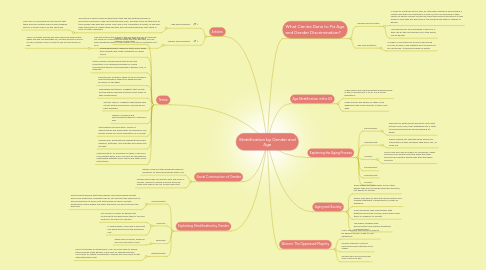
1. Social Construction of Gender
1.1. Gender roles are often assigned based on old beliefs of what each gender was to do.
1.2. Women have been confined to very few roles in society, merely to 'gossip' and stay at home. While men were to go off to work each day.
2. Explaining Stratification by Gender
2.1. Functionalists:
2.1.1. Functionalists believe that these gender roles have helped society work more effectively, however they do not say that men should be at work and women at home, just that homes do need a divided home/work couple where one plays the home role and one plays the work role.
2.2. Conflicts:
2.2.1. Any division of labor by gender into instrumental and expressive tasks is far from neutral in its impact on women.
2.2.2. In relationships, men have a dominant role while women play the emotional role.
2.3. Feminists:
2.3.1. Agree with Conflicts, however also look at political roles.
2.4. Interactionists:
2.4.1. Point out studies of interactions: men are more likely to ignore things said by other gender, more likely to change the topic, more likely to initiate conversation. Women are more likely to get interrupted than men.
3. Terms:
3.1. Sexism: Ideology that one sex is superior to the other.
3.2. Sexual harassment: Behavior that occurs when work benefits are made contigient on sexual favors.
3.3. Glass Ceiling: Invisible barrier that blocks the promotion of an qualified individual in a work environment based on the individual's gender, race, or ethnicity.
3.4. Gerontology: scientific study of the sociological and psychological aspects of aging and the problems of the aged.
3.5. Disengagement theory: Suggests that society and the aging individual mutually sever many of their relationships.
3.6. Activity Theory: Suggests that people who remain active and socially involved will be best-adjusted.
3.7. Ageism: Prejudice and discrimination based on a person's age.
3.8. Instrumental Discrimination: Denial of opportunities and equal rights to individuals and groups based on normal operations of a society.
3.9. Gender Role: Expectations regarding the proper behavior, attitudes, and activities and males and females.
3.10. Instrumentality: An emphasis on tasks, a focus on more distant goals, and a concern for the external relationship between one's family and other social instructions.
4. Articles:
4.1. Age Discrimination:
4.1.1. This article is about a woman who thinks that she was getting passed for promotions because of the fact that she was older, and didn't look as attractive as the younger lady who was chose. This case is not completely accurate, as she had been fired due to a creepy thing she said, and she had groped her own chest in front of other coworkers.
4.1.1.1. This story is conflicting due to the fact that there was also another person who allegedly quit for a similar reason on the same day.
4.2. Gender Discrimination:
4.2.1. This article talks about how in the oil fields women are typically not hired on or paid less than what the men get paid, and are even threatened about if they were to call the oil industries out on it.
4.2.1.1. This is not right, women and men should be given equal rights and pay for what they do, as they did just as much as men, possibly more in order to pay for the decline in pay.
5. Women: The Oppressed Majority
5.1. Major institutes tend to be inclined to go against women in day-to-day operations.
5.2. Women started to actually notice the sexist attitudes from others.
5.3. Women earn less money than men in terms of pay.
6. Aging and Society
6.1. Some elders are treated well, but in other beliefs they are not being productive and thus, not helpful to society.
6.2. Elderly may have to deal with discrimination and unequal treatment in employment, as well as prejudice.
6.3. Some societies view older people with greatness and ease of living, while others view them as unhelpful to society.
6.4. The elderly struggle with discrimination and unequal treatment in employment.
7. Explaining the Aging Process
7.1. Functionalist:
7.1.1. Approach of death forces people to drop most of their social roles, then withdraws into a state of increasing inactivity while preparing for death.
7.2. Interactionist:
7.2.1. Elderly people still need the same amount of interactions as they did when they were, say, 40 years old.
7.3. Conflict:
7.3.1. Social class also has an impact on individuals, upper class has more health insurance while the lower class still face greater health risks than the upper class did.
7.4. Functionalist:
7.5. Interactionist:
7.6. Conflict:
8. Age Stratification in the US
8.1. Older people are now the fastest growing group in the US going from 4.1% to 12.4% of the population.
8.2. Older women and people of other races experience the most difficulty in their older ages.
9. What Can be Done to Fix Age and Gender Discrimination?
9.1. Gender Discrimination
9.1.1. In order to avoid this sort of bias, all interviews should be done behind a curtain and with voice distorters so that no one can be biased in their choice of person chosen for the job, then they bring in the person if they know for sure they will give them a job and give pay with no regards to gender.
9.1.2. Jobs should only be considered in terms of if they can do the job the best out of the group, not by gender.
9.2. Age Discrimination
9.2.1. In order to avoid this sort of bias, they should not look at ages in the slightest and it should not be mentioned. It should be based on ability.
